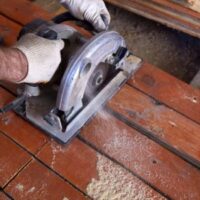Cutting and Saw Accidents On the Job

Injuries caused by saws, both handsaws and power saws, are extremely common in a wide range of construction jobs, as well as in other fields. Construction workers, especially carpenters and roofers, frequently use various types of saws in their day-to-day duties. Warehouse workers, as well as maintenance workers, plumbers, vehicle mechanics, manufacturing, electrical work, gardening and landscaping, and even in some food service jobs. Certain types of saws pose greater risks of severe injury than others, but the regular or occasional use of any type of saw in a person’s job can increase the likelihood of a catastrophic injury, including a traumatic amputation.
What should you know about cutting and saw injuries on the job in Maryland? Our Maryland workers’ compensation lawyers can tell you more.
Common Types of Saws Involved in Accidents at Work
What types of saws are most commonly associated with serious work-related injuries? Consider the following types of saws and accidents that can happen in various types of industries cited above:
- Table saw accidents, which often happen due to improper training or lack of safety guards;
- Bandsaw accidents, which typically occur due to improper safety guards or slippage of materials;
- Chainsaw accidents, which can occur from improper training or saw defects;
- Reciprocating saw accidents, which often happen when the user loses control of the saw;
- Circular saw accidents, which usually happen due to “kickback”;
- Miter saw accidents, which can occur due to improper training or a defective safety guard; and
- Hand saw accidents, which often happen if the worker’s clothes get caught near the blade or the worker loses control of the hand saw and the saw slips.
These types of saws can be used in many different work environments to cut wood, metal, fabric, and composite materials. According to a recent report from NPR, table saws tend to be associated with the highest rates of injury and “are widely considered the most dangerous power tool.” They are associated with about 30,000 injuries requiring medical attention every year, and about 4,000 annual amputation injuries, most often among construction contractors and carpenters.
Most Common Injuries Associated with Cutting and Saw Work Injuries
What are the most common types of work injuries associated with saws? By far, traumatic amputations are the most serious and common type of injury linked to saw accidents on the job.
According to a recent study published in the Journal of Hand Surgery Global Online, researchers reported that injuries to the hands and upper extremities are most common in saw accidents, and those injuries are, most frequently, traumatic amputations. Such injuries result in a significant number of missed workdays and permanent disabilities.
Contact a Maryland Workers’ Compensation Attorney
If you sustained a serious injury in a power saw or hand saw accident at work, you may be eligible for workers’ compensation benefits. Workers’ compensation can cover the cost of your medical care and a percentage of your lost wages, and if you experienced a traumatic amputation, you may also be eligible for permanent disability benefits. You should get in touch with one of the experienced Maryland workers’ compensation attorneys at the Law Offices of Steinhardt, Siskind and Lieberman, LLC for assistance. Contact our firm today to learn more about how we can help with your case.
Sources:
jhsgo.org/article/S2589-5141(23)00021-X/pdf
npr.org/2024/04/02/1241148577/table-saw-injuries-safety-sawstop-cpsc


